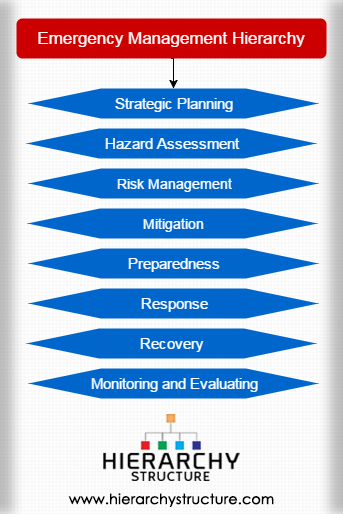Emergencies are never called for and therefore they are absolutely no ways of knowing when any disaster, man-made or natural may occur with mass destruction and invariable loss to all resources including human lives. Though these occurrences cannot be stopped, but one can definitely prepare oneself for the worst and handle things diligently if something happens. For this a proper emergency management hierarchy is required. There can be committees set, organizations made and general rules set at different levels that shall not only help in handling such situations in a better manner but would also decrease the chaos and disorganization among people when they are aware of what to do in such emergencies.

A proper emergency management must be inclusive of proper “strategic planning, hazard assessment, risk management, disaster management, monitoring and evaluation”.
- Strategic planning must be done in advance for minimum losses. A comprehensive plan has to be framed previously with proper instructions to the support staff
- Hazard assessment on various hazards, vulnerabilities and resources available to deal with the same is the top most priority. Risk depends upon the capability of the organization in minimizing any exposure to the above factors by assessing them previously and having a plan of action for the same.
- Risk management with proper estimation and evaluation of the risks that might be faced. This also includes control planning and devising ways to deal with them in the most reliable manner.
- Structural and non structural mitigation provisions that a brief idea as to mitigate any losses occurring in future. Comprehensive Insurance plans and financial support systems are one of the best ways to mitigate any financial losses that may occur due to the emergency.
- Evaluation of preparedness in terms of emergency responses, business recovery, and training.
- Response procedure in terms of early warnings, evacuation plans, assistance to victims, handling any human casualties and providing with emergency first-aid supplies at the place of occurrence to each and everyone present.
- Recovery involving proper damage assessment, debris removal, restoration, reconstruction and finally the revival of the economic situation to bring everything back on track once again.
- And lastly monitoring and evaluating the community, environments and systems about the success or failure of plans and thereby omitting any future policies accordingly. These include proper communication, coordination and consultation for a good revaluated policy to come into picture. Highlighting the relation between risk management and the disaster management, this provides for a perfect enclosure to the complete plan.
A proper risk evaluation and emergency management is essential for any organization to deal with disasters and recuperate in the fastest and most efficient manner. Proper implementation not only helps in dealing any future problems but also ensures a consolidated way out at any moment the need arises.
This particular approach focuses on a comprehensive plan to deal with all disasters instead of focusing on one particular disaster thereby making it one of the most reliable and sought after emergency management scheme devised to cater to any occurring emergencies.
